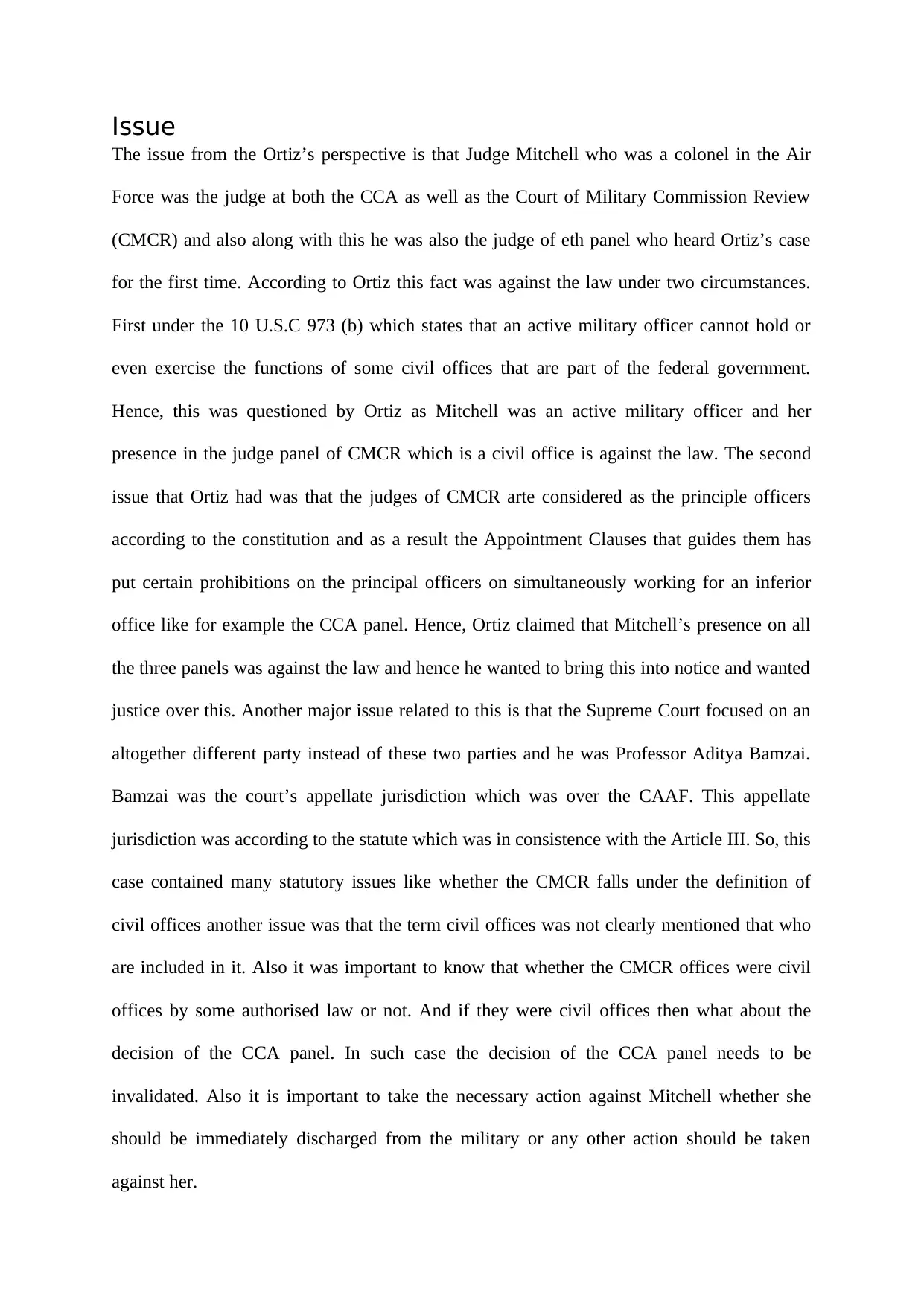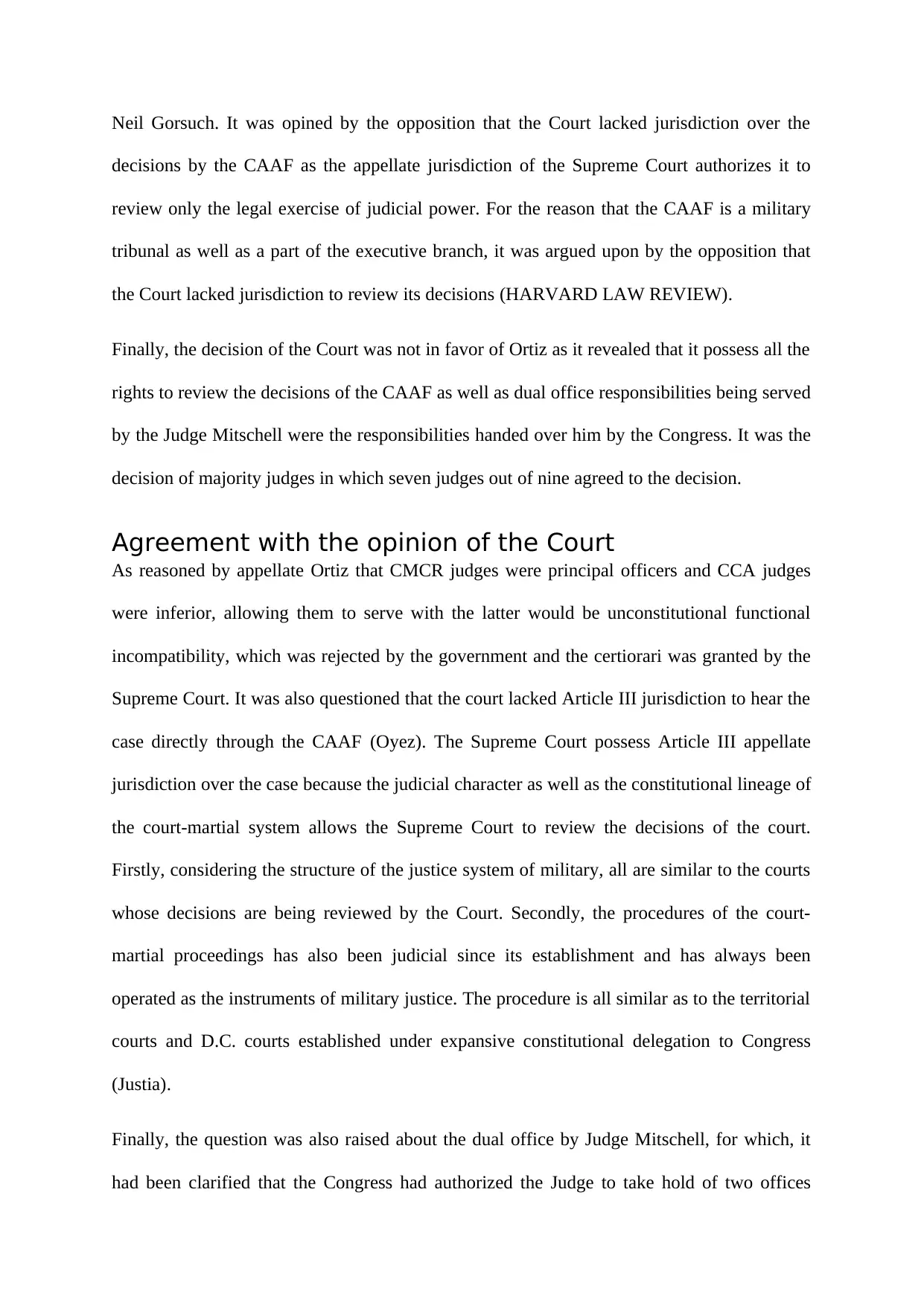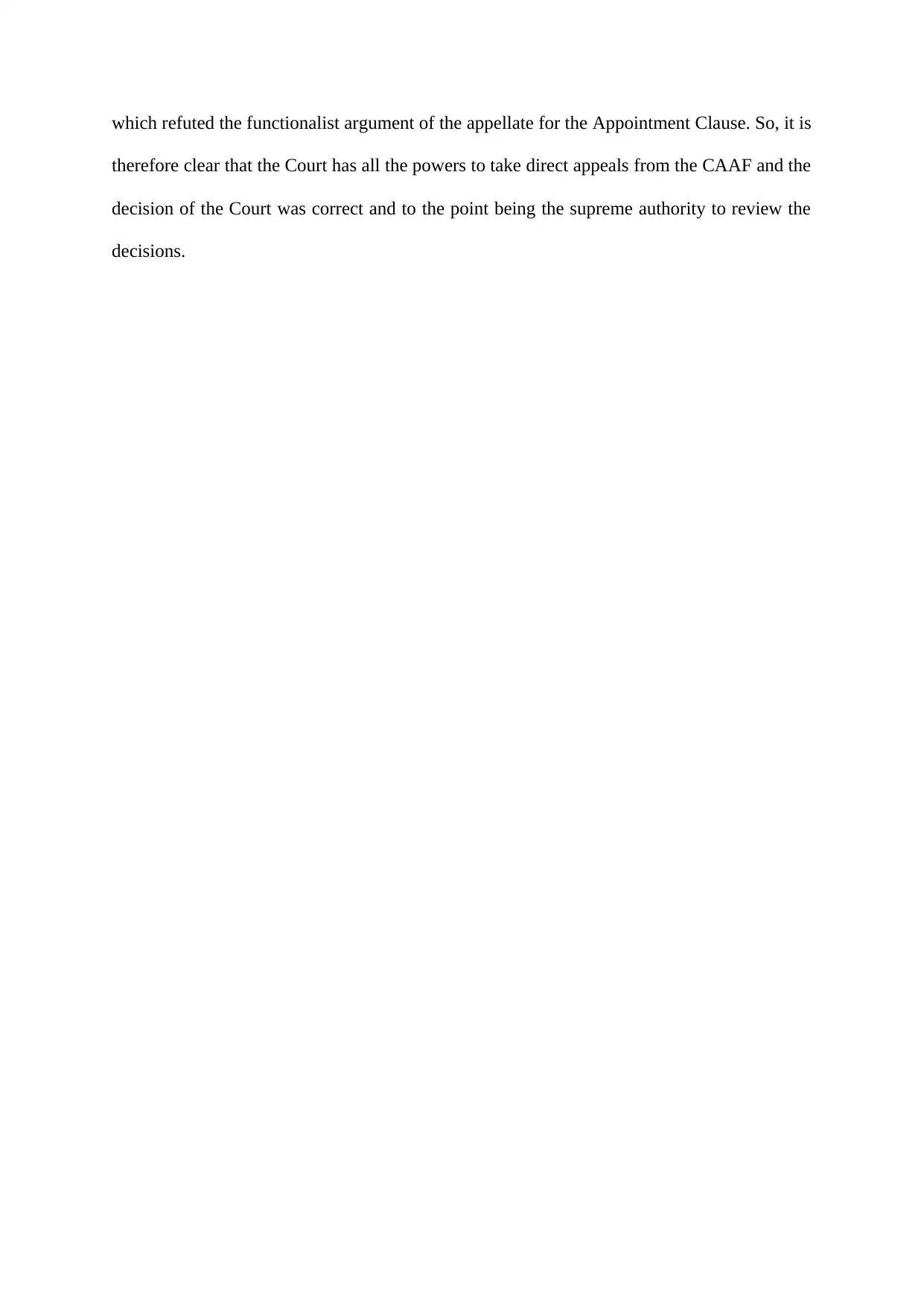Ortiz v. United States: Examining Jurisdiction and Military Justice
VerifiedAdded on 2023/05/30
|7
|1681
|64
Case Study
AI Summary
This case study delves into Ortiz v. United States, where Keanu Ortiz challenged his conviction for possessing and distributing child pornography under the Uniform Code of Military Justice. The central issue revolves around Judge Mitchell's simultaneous service on the Court of Military Commission Review (CMCR) and the Air Force Court of Criminal Appeals (CCA), which Ortiz argued violated federal law and the Constitution's Appointments Clause. The Supreme Court, in a 7-2 decision, held that it had jurisdiction to review decisions by the US Court of Appeals for the Armed Forces and that Judge Mitchell's dual service did not violate the Appointments Clause, as Congress had authorized the dual roles. The Court reasoned that the military justice system's structure and procedures allowed for Supreme Court review and that Congress had the authority to permit the dual office holding, ultimately upholding Ortiz's conviction. Desklib provides access to similar case studies and solved assignments for students.

Ortiz v. United States
Paraphrase This Document
Need a fresh take? Get an instant paraphrase of this document with our AI Paraphraser

Facts
According to the case Keanu Ortiz was convicted of the offense of possessing as well as
distributing child pornography which is in violation of the Uniform Code of Military Justice.
Because of this act he was convicted by a court martial. This was followed by several appeals
by Ortiz at each standard stage of the legal system of military department and in the end he
reached to the Supreme Court for justice. The Air Force Court of Criminal Appeals (CCA)
affirmed his conviction. As a result Ortiz wanted to raise another appeal which was denied by
the Court of Appeals for the Armed Forces (CAAF). This was argued by Ortiz by saying that
he deserved a second chance at an appeal. Ortiz also said that he deserved appeal to a
different CCA panel, this is so because he believed that the first panel who heard his case was
a result of violation of both the federal law and the constitution. Article III of the constitution
has a major role to play in this case. Article III which describes about the jurisdiction of the
Supreme Court states that cases that are related to ambassadors, or any other public ministers
as well as Consuls and the cases in which the State also is a party than such cases falls under
the original Jurisdiction of the Supreme Court. Apart from the above mentioned bodies
involved in a case the Supreme Court has an appellate jurisdiction and not original
jurisdiction according to the law as well as matter of fact though, this may have certain
exceptions according to the regulations passed by the Congress. Apart from this the Federal
courts have limited jurisdiction under them and which is guided by both the statutory
provisions as well as the constitution’s authorization. The case of Ortiz has been consolidated
by the Supreme Court with two other cases and that is the Cox v. United States and the other
one is the Dalmazzi v. United States. These cases are related to the case of Ortiz in the
manner that the Supreme Court dismissed all the other consolidated cases on the grounds that
these cases raised statutory jurisdiction because of which the disposition makes it less
important to resolve.
According to the case Keanu Ortiz was convicted of the offense of possessing as well as
distributing child pornography which is in violation of the Uniform Code of Military Justice.
Because of this act he was convicted by a court martial. This was followed by several appeals
by Ortiz at each standard stage of the legal system of military department and in the end he
reached to the Supreme Court for justice. The Air Force Court of Criminal Appeals (CCA)
affirmed his conviction. As a result Ortiz wanted to raise another appeal which was denied by
the Court of Appeals for the Armed Forces (CAAF). This was argued by Ortiz by saying that
he deserved a second chance at an appeal. Ortiz also said that he deserved appeal to a
different CCA panel, this is so because he believed that the first panel who heard his case was
a result of violation of both the federal law and the constitution. Article III of the constitution
has a major role to play in this case. Article III which describes about the jurisdiction of the
Supreme Court states that cases that are related to ambassadors, or any other public ministers
as well as Consuls and the cases in which the State also is a party than such cases falls under
the original Jurisdiction of the Supreme Court. Apart from the above mentioned bodies
involved in a case the Supreme Court has an appellate jurisdiction and not original
jurisdiction according to the law as well as matter of fact though, this may have certain
exceptions according to the regulations passed by the Congress. Apart from this the Federal
courts have limited jurisdiction under them and which is guided by both the statutory
provisions as well as the constitution’s authorization. The case of Ortiz has been consolidated
by the Supreme Court with two other cases and that is the Cox v. United States and the other
one is the Dalmazzi v. United States. These cases are related to the case of Ortiz in the
manner that the Supreme Court dismissed all the other consolidated cases on the grounds that
these cases raised statutory jurisdiction because of which the disposition makes it less
important to resolve.

Issue
The issue from the Ortiz’s perspective is that Judge Mitchell who was a colonel in the Air
Force was the judge at both the CCA as well as the Court of Military Commission Review
(CMCR) and also along with this he was also the judge of eth panel who heard Ortiz’s case
for the first time. According to Ortiz this fact was against the law under two circumstances.
First under the 10 U.S.C 973 (b) which states that an active military officer cannot hold or
even exercise the functions of some civil offices that are part of the federal government.
Hence, this was questioned by Ortiz as Mitchell was an active military officer and her
presence in the judge panel of CMCR which is a civil office is against the law. The second
issue that Ortiz had was that the judges of CMCR arte considered as the principle officers
according to the constitution and as a result the Appointment Clauses that guides them has
put certain prohibitions on the principal officers on simultaneously working for an inferior
office like for example the CCA panel. Hence, Ortiz claimed that Mitchell’s presence on all
the three panels was against the law and hence he wanted to bring this into notice and wanted
justice over this. Another major issue related to this is that the Supreme Court focused on an
altogether different party instead of these two parties and he was Professor Aditya Bamzai.
Bamzai was the court’s appellate jurisdiction which was over the CAAF. This appellate
jurisdiction was according to the statute which was in consistence with the Article III. So, this
case contained many statutory issues like whether the CMCR falls under the definition of
civil offices another issue was that the term civil offices was not clearly mentioned that who
are included in it. Also it was important to know that whether the CMCR offices were civil
offices by some authorised law or not. And if they were civil offices then what about the
decision of the CCA panel. In such case the decision of the CCA panel needs to be
invalidated. Also it is important to take the necessary action against Mitchell whether she
should be immediately discharged from the military or any other action should be taken
against her.
The issue from the Ortiz’s perspective is that Judge Mitchell who was a colonel in the Air
Force was the judge at both the CCA as well as the Court of Military Commission Review
(CMCR) and also along with this he was also the judge of eth panel who heard Ortiz’s case
for the first time. According to Ortiz this fact was against the law under two circumstances.
First under the 10 U.S.C 973 (b) which states that an active military officer cannot hold or
even exercise the functions of some civil offices that are part of the federal government.
Hence, this was questioned by Ortiz as Mitchell was an active military officer and her
presence in the judge panel of CMCR which is a civil office is against the law. The second
issue that Ortiz had was that the judges of CMCR arte considered as the principle officers
according to the constitution and as a result the Appointment Clauses that guides them has
put certain prohibitions on the principal officers on simultaneously working for an inferior
office like for example the CCA panel. Hence, Ortiz claimed that Mitchell’s presence on all
the three panels was against the law and hence he wanted to bring this into notice and wanted
justice over this. Another major issue related to this is that the Supreme Court focused on an
altogether different party instead of these two parties and he was Professor Aditya Bamzai.
Bamzai was the court’s appellate jurisdiction which was over the CAAF. This appellate
jurisdiction was according to the statute which was in consistence with the Article III. So, this
case contained many statutory issues like whether the CMCR falls under the definition of
civil offices another issue was that the term civil offices was not clearly mentioned that who
are included in it. Also it was important to know that whether the CMCR offices were civil
offices by some authorised law or not. And if they were civil offices then what about the
decision of the CCA panel. In such case the decision of the CCA panel needs to be
invalidated. Also it is important to take the necessary action against Mitchell whether she
should be immediately discharged from the military or any other action should be taken
against her.
⊘ This is a preview!⊘
Do you want full access?
Subscribe today to unlock all pages.

Trusted by 1+ million students worldwide

Court Procedures
It was decided by the Supreme Court that it has jurisdiction to review the decisions by the US
Court of Appeals for the Armed Forces. The simultaneous service by Judge Martin Mitchell
on the CMCR and AFCCA was not considered to be violating the Appointments Clause. The
opinion of the court was delivered by the Justice Elena Kagan as the opinion by 7 on 2
majority decision.
Initially, it was found by the Court that the CAAF is not an Article III court and so it does not
eradicate the jurisdiction of the Supreme Court to review its decisions. The Supreme Court
undisputedly reviews the decisions of various non-Article III courts, which include the state
courts as well as the courts of the District of Columbia. However, CAAF being a part of the
Executive Branch cannot deny the jurisdiction of the Supreme Court upon it as it is a
permanent court of record that has been established by Congress, and being the Supreme
Court, it possess all the rights to appropriately exercise jurisdiction upon it.
Secondly, taking into consideration, the simultaneous service on CMCR and AFCCA by
Judge Mitchell, it was revealed by the Court that the express approval to allocate military
officers to the CMCR under 950f (b) (2) had been considered essential as well as sufficient to
exempt him from 973(b) (2) (A). Judge Mitchell was placed on CMCR by the Secretary of
Defense and after his subsequent appointment to AFCCA by the order of president could not
have contradicted the action taken by the Secretary earlier but could only have ratified and
that was what was done considering the seriousness of situation. Regarding the constitutional
claim, it was held by the Court that it has never understood the Appointments Clause to levy
rules regarding dual service. Justice Clarence Thomas also filed the agreement opinion with
the other judges and joined the opinion of majority in full but stated that the conclusion
reached by the Court was reliable with the understanding of the creators of the judicial power.
On the other hand, Justice Samuel Alito filed the nonconforming opinion along with Justice
It was decided by the Supreme Court that it has jurisdiction to review the decisions by the US
Court of Appeals for the Armed Forces. The simultaneous service by Judge Martin Mitchell
on the CMCR and AFCCA was not considered to be violating the Appointments Clause. The
opinion of the court was delivered by the Justice Elena Kagan as the opinion by 7 on 2
majority decision.
Initially, it was found by the Court that the CAAF is not an Article III court and so it does not
eradicate the jurisdiction of the Supreme Court to review its decisions. The Supreme Court
undisputedly reviews the decisions of various non-Article III courts, which include the state
courts as well as the courts of the District of Columbia. However, CAAF being a part of the
Executive Branch cannot deny the jurisdiction of the Supreme Court upon it as it is a
permanent court of record that has been established by Congress, and being the Supreme
Court, it possess all the rights to appropriately exercise jurisdiction upon it.
Secondly, taking into consideration, the simultaneous service on CMCR and AFCCA by
Judge Mitchell, it was revealed by the Court that the express approval to allocate military
officers to the CMCR under 950f (b) (2) had been considered essential as well as sufficient to
exempt him from 973(b) (2) (A). Judge Mitchell was placed on CMCR by the Secretary of
Defense and after his subsequent appointment to AFCCA by the order of president could not
have contradicted the action taken by the Secretary earlier but could only have ratified and
that was what was done considering the seriousness of situation. Regarding the constitutional
claim, it was held by the Court that it has never understood the Appointments Clause to levy
rules regarding dual service. Justice Clarence Thomas also filed the agreement opinion with
the other judges and joined the opinion of majority in full but stated that the conclusion
reached by the Court was reliable with the understanding of the creators of the judicial power.
On the other hand, Justice Samuel Alito filed the nonconforming opinion along with Justice
Paraphrase This Document
Need a fresh take? Get an instant paraphrase of this document with our AI Paraphraser

Neil Gorsuch. It was opined by the opposition that the Court lacked jurisdiction over the
decisions by the CAAF as the appellate jurisdiction of the Supreme Court authorizes it to
review only the legal exercise of judicial power. For the reason that the CAAF is a military
tribunal as well as a part of the executive branch, it was argued upon by the opposition that
the Court lacked jurisdiction to review its decisions (HARVARD LAW REVIEW).
Finally, the decision of the Court was not in favor of Ortiz as it revealed that it possess all the
rights to review the decisions of the CAAF as well as dual office responsibilities being served
by the Judge Mitschell were the responsibilities handed over him by the Congress. It was the
decision of majority judges in which seven judges out of nine agreed to the decision.
Agreement with the opinion of the Court
As reasoned by appellate Ortiz that CMCR judges were principal officers and CCA judges
were inferior, allowing them to serve with the latter would be unconstitutional functional
incompatibility, which was rejected by the government and the certiorari was granted by the
Supreme Court. It was also questioned that the court lacked Article III jurisdiction to hear the
case directly through the CAAF (Oyez). The Supreme Court possess Article III appellate
jurisdiction over the case because the judicial character as well as the constitutional lineage of
the court-martial system allows the Supreme Court to review the decisions of the court.
Firstly, considering the structure of the justice system of military, all are similar to the courts
whose decisions are being reviewed by the Court. Secondly, the procedures of the court-
martial proceedings has also been judicial since its establishment and has always been
operated as the instruments of military justice. The procedure is all similar as to the territorial
courts and D.C. courts established under expansive constitutional delegation to Congress
(Justia).
Finally, the question was also raised about the dual office by Judge Mitschell, for which, it
had been clarified that the Congress had authorized the Judge to take hold of two offices
decisions by the CAAF as the appellate jurisdiction of the Supreme Court authorizes it to
review only the legal exercise of judicial power. For the reason that the CAAF is a military
tribunal as well as a part of the executive branch, it was argued upon by the opposition that
the Court lacked jurisdiction to review its decisions (HARVARD LAW REVIEW).
Finally, the decision of the Court was not in favor of Ortiz as it revealed that it possess all the
rights to review the decisions of the CAAF as well as dual office responsibilities being served
by the Judge Mitschell were the responsibilities handed over him by the Congress. It was the
decision of majority judges in which seven judges out of nine agreed to the decision.
Agreement with the opinion of the Court
As reasoned by appellate Ortiz that CMCR judges were principal officers and CCA judges
were inferior, allowing them to serve with the latter would be unconstitutional functional
incompatibility, which was rejected by the government and the certiorari was granted by the
Supreme Court. It was also questioned that the court lacked Article III jurisdiction to hear the
case directly through the CAAF (Oyez). The Supreme Court possess Article III appellate
jurisdiction over the case because the judicial character as well as the constitutional lineage of
the court-martial system allows the Supreme Court to review the decisions of the court.
Firstly, considering the structure of the justice system of military, all are similar to the courts
whose decisions are being reviewed by the Court. Secondly, the procedures of the court-
martial proceedings has also been judicial since its establishment and has always been
operated as the instruments of military justice. The procedure is all similar as to the territorial
courts and D.C. courts established under expansive constitutional delegation to Congress
(Justia).
Finally, the question was also raised about the dual office by Judge Mitschell, for which, it
had been clarified that the Congress had authorized the Judge to take hold of two offices

which refuted the functionalist argument of the appellate for the Appointment Clause. So, it is
therefore clear that the Court has all the powers to take direct appeals from the CAAF and the
decision of the Court was correct and to the point being the supreme authority to review the
decisions.
therefore clear that the Court has all the powers to take direct appeals from the CAAF and the
decision of the Court was correct and to the point being the supreme authority to review the
decisions.
⊘ This is a preview!⊘
Do you want full access?
Subscribe today to unlock all pages.

Trusted by 1+ million students worldwide

Bibliography
HARVARD LAW REVIEW. Ortiz v. United States. 9 November 2018. 22 November 2018.
Justia. Ortiz v. United States, 585 U.S. ___ (2018). 2018. 22 November 2018.
Oyez. Ortiz v. United States. 2018. 22 November 2018.
HARVARD LAW REVIEW. Ortiz v. United States. 9 November 2018. 22 November 2018.
Justia. Ortiz v. United States, 585 U.S. ___ (2018). 2018. 22 November 2018.
Oyez. Ortiz v. United States. 2018. 22 November 2018.
1 out of 7
Related Documents
Your All-in-One AI-Powered Toolkit for Academic Success.
+13062052269
info@desklib.com
Available 24*7 on WhatsApp / Email
![[object Object]](/_next/static/media/star-bottom.7253800d.svg)
Unlock your academic potential
Copyright © 2020–2025 A2Z Services. All Rights Reserved. Developed and managed by ZUCOL.





